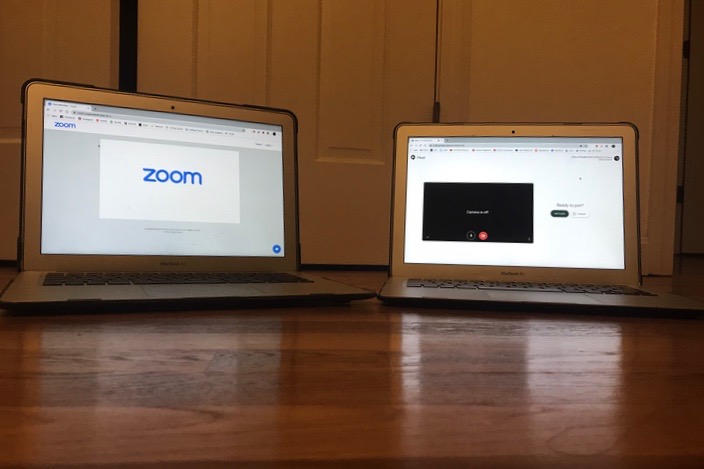Teachers swing between Zoom and Google Meets for online classes
Credit: Atharva Weling
With schools closed for the rest of the year, WHS teachers are now faced with a choice between Google Meet and Zoom for their online classes. “It appears that most high school teachers that I know use Zoom,” said history teacher Sean Chase, who prefers to use the aforementioned software for his classes.
April 28, 2020
Ever since mid-March, when the spread of COVID-19 forced towns across the country to close schools, teachers have been working to find the ideal online alternative to a normal classroom setting. Now that Gov. Charlie Baker has declared that Massachusetts schools will remain closed until the end of the school year, WHS teachers will have to find the software that works best for them. The two options that have become the most widely-used are Zoom and Google Meet.
While some teachers are still hesitant regarding their decision, many have already decided. Math and computer science teacher Molly Kooshan is one of these teachers.
“I prefer to use Zoom for my classes,” Kooshan said.
Kooshan chose Zoom because it gives her more control as host of the meeting than Google Meet does. Kooshan likes being able to end the meeting for all her students and to decide whether or not her students are allowed to mute or rename themselves in the call.
History teacher Sean Chase is also partial to using Zoom for his classroom calls. His preference for Zoom lies not only in the features it provides, but also in the comparatively better quality of its calls. He decries Google Meet calls as being clunky, with a strong tendency to lag and freeze, preventing an effective learning experience.
“Watching my elementary school-aged children use it has been frustrating,” Chase said. “I feel bad for their teachers. The site just keeps backfiring on them.”
Many students feel the same way about Google Meet’s audio and video quality. According to junior Aiden Zhang, the already short class time of 30 minutes means that having constant interruptions is a serious problem when trying to learn.
“Google Meet’s tendency to cut out and freeze your screen greatly inhibits my ability to understand classes, which are already short as is,” Zhang said.
While Google Meet has frustrated both students and teachers alike, Zoom has provided the same service with much better results.
“Zoom has a better picture quality and is more reliable in terms of performance,” Chase said.
Despite many having a strong preference for one over the other, there are some teachers and students who are indifferent when it comes to choosing a medium for their online communication. For them, simply having the chance to connect during these difficult times is far too important for them to care exactly how they do it.
“My students seem to like using Zoom, [but] I think many of them enjoy being able to connect through video regardless of the medium [we use to chat],” Kooshan said.
English teacher Gwen Goldin feels the same way. She uses Google Meet on the advice of the administration, but both Goldin and her students haven’t chosen a superior software. With some of her students saying that only Zoom works on their computers and others saying that only Google Meet works on their computers, she has come to the understanding that it doesn’t really matter.
“Neither has been more or less stable than the other, and both provide the basics that we need for remote class, [so] I don’t really have a preference,” Goldin said.
However, while there can be plenty of disagreement over whether Zoom or Google Meet is better, or whether the debate even matters at all, one sentiment seems to be common throughout WHS: Neither Zoom or Google Meet can replace the normal in-class experience.
“Zoom does not, however, replicate the magic and the energy of the classroom,” Chase said. “Sadly that [has] been lost amongst all of this, but it’s outside of all of our control.”
Until the fateful day comes when the world is no longer as heavily afflicted by the virus and social distancing can come to an end, we cannot return to the classroom. All we can do now is make do with whatever online tool our faculty chooses and put our efforts towards using it as best as we can.
“I would like to remind students that, unfortunately, this is our new reality now,” Chase said. “So, turn your screens on.”





![Last Wednesday, the Wayland School Committee gathered to discuss a number of topics regarding the health curriculum and Innovation Career Pathway course. Another large topic of conversation was the ways to potentially mitigate distracting cell phone usage. "These [phones] are going to distract your learning and social relationships," Superintendent David Fleishman said. "That's concrete right there."](https://waylandstudentpress.com/wp-content/uploads/2025/06/Screenshot-2025-06-04-at-9.49.31 PM-1200x886.png)



























![Troy Hoyt finishes the Boston Marathon, running for the Hoyt Foundation. T. Hoyt is the son of Hoyt Foundation CEO Russ Hoyt.
“[Running a marathon] might seem like a big thing, when it’s presented to you at first, but if you break it up and just keep telling yourself, “Yes, you can,” you can start chipping away at it. And before you know it, you’ll be running the whole 26 miles, and you won’t even think twice about it.” T. Hoyt said.](https://waylandstudentpress.com/wp-content/uploads/2025/04/C36E8761-1CBB-452E-9DF2-543EF7B1095E_1_105_c.jpeg)













































